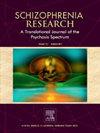Subcortical brain abnormalities and cognitive function in individuals with psychosis and their unaffected relatives: A normative modeling approach
IF 3.5
2区 医学
Q1 PSYCHIATRY
引用次数: 0
Abstract
Previous research has shown subcortical aberrations in individuals with psychosis (probands) and their unaffected first-degree relatives. However, few studies directly evaluated whether the pattern of aberration is similar across multiple subcortical regions and across probands and relatives, and whether the relationship between subcortical aberrations and cognition is similar between probands and unaffected relatives. To address these questions, this study employed a normative modeling approach and examined deviation scores of five subcortical regions from the normative range of 127 probands, 86 unaffected relatives, and 50 controls from the Psychosis Human Connectome Project. Cognitive performance was assessed using the Brief Assessment of Cognition in Schizophrenia (BACS). The pattern of deviations across subcortical regions differed between probands and relatives, such that compared to relatives, probands had more negative deviations in the hippocampus, thalamus and amygdala but not in other subcortical regions. Further, compared to the reference norm, both probands and relatives showed negative hippocampal deviations, but only probands had negative thalamic, amygdala, and nucleus accumbens deviations. In both hippocampus and thalamus, negative deviations were related to poor cognitive performance across both groups. These findings suggest that the pattern of structural aberration is not uniform across subcortical regions across probands and relatives. Negative hippocampal deviations appear to reflect genetic risk to psychosis, whereas negative thalamic, amygdala, and nucleus accumbens deviations may be psychosis specific. Subcortical structural aberrations may contribute to poor cognition in both probands and unaffected relatives.
精神病患者及其未受影响亲属的皮质下脑异常和认知功能:一种规范的建模方法。
先前的研究表明,在精神病患者(先证者)及其未受影响的一级亲属中存在皮层下畸变。然而,很少有研究直接评估在多个皮层下区域和先证者与亲属之间的畸变模式是否相似,以及先证者与未受影响的亲属之间的皮层下畸变与认知之间的关系是否相似。为了解决这些问题,本研究采用了一种规范的建模方法,并检查了127个先证者、86个未受影响的亲属和50个来自精神病人类连接组项目的对照组的五个皮质下区域的偏差评分。使用精神分裂症患者认知能力简要评估(BACS)评估认知表现。先证者和亲属在皮层下区域的偏差模式有所不同,例如,与亲属相比,先证者在海马、丘脑和杏仁核中有更多的负偏差,而在其他皮层下区域则没有。此外,与参考常模相比,先证者和亲属均表现出负海马偏差,但只有先证者表现出负丘脑、杏仁核和伏隔核偏差。在海马体和丘脑中,负偏差与两组认知表现差有关。这些发现表明,在先证者和亲属的皮层下区域,结构畸变的模式并不均匀。海马负性偏差似乎反映了精神病的遗传风险,而丘脑、杏仁核和伏隔核负性偏差可能是精神病特有的。皮层下结构畸变可能导致先证者和未受影响亲属的认知能力低下。
本文章由计算机程序翻译,如有差异,请以英文原文为准。
求助全文
约1分钟内获得全文
求助全文
来源期刊

Schizophrenia Research
医学-精神病学
CiteScore
7.50
自引率
8.90%
发文量
429
审稿时长
10.2 weeks
期刊介绍:
As official journal of the Schizophrenia International Research Society (SIRS) Schizophrenia Research is THE journal of choice for international researchers and clinicians to share their work with the global schizophrenia research community. More than 6000 institutes have online or print (or both) access to this journal - the largest specialist journal in the field, with the largest readership!
Schizophrenia Research''s time to first decision is as fast as 6 weeks and its publishing speed is as fast as 4 weeks until online publication (corrected proof/Article in Press) after acceptance and 14 weeks from acceptance until publication in a printed issue.
The journal publishes novel papers that really contribute to understanding the biology and treatment of schizophrenic disorders; Schizophrenia Research brings together biological, clinical and psychological research in order to stimulate the synthesis of findings from all disciplines involved in improving patient outcomes in schizophrenia.
 求助内容:
求助内容: 应助结果提醒方式:
应助结果提醒方式:


